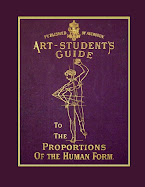
This is from Littell's The Living Age, Volume XXXII, January, February, March 1852.
In and article titled PHYSIOGNOMY, and in florid text the author proposes an extensive theory of Physiognomy which he find support for in three books of the time:
1. Nosology; or, Hints towards a Classification of Noses. By Eden Warwice. 1848.
2. Polyclet, oder van den Maassen des Menschen, u. s. w. Polycletus, or on the Proportions of the Human Figure, according to Sex and Age, with the Natural Dimensions by Rhenish Measure ; with a Treatise on the Differences between the Features of the Face and the Form of the Head in the various Races of the Earth ; being a continuation of Peter Camper, &c. By G. Schadow, Director of the Royal Academy at Berlin. la 2 parts, with 58 plates. Berlin, 1835.
Download a English translation of the first part of Dr. Schadow's book, the part that is on proportions of the human form, at Figure-Drawings.com or purchase a paperback copy of The Art Student's Guide to the Proportions of the Human Form
at Amazon.com.
at Amazon.com.
 3. The Anatomy And Philosophy Of Expression As Connected With The Fine Arts
3. The Anatomy And Philosophy Of Expression As Connected With The Fine ArtsBy Sir Charles Bell, K. H. 4th Edition. 1847.
"There is no single object presented to our senses which engrosses so large a share of our thoughts, emotions, and associations as that small portion of flesh and hlood a hand may cover, which constitutes the human face. There is nothing we gaze upon with such admiration, think of with so much fondness, long for with such yearning, and remember with such fidelity—nothing that gladdens us with such magic power, haunts us with such fearful pertinacity—common as it is, meeting us at every turn, there is nothing we peer into with such unflagging curiosity, or study with such insatiate interest. Nor is there anything surprising in the effect thus produced. For the face is not, like the hand or foot, a mere portion of ourself or of our neighbor; it is the very representative of our race —the one synonym of humanity..."This is the portion influenced by Johann Gottfreid Schadow's book:
"...Following, therefore, this fundamental rule, which the Greek elaborated, however he was limited in developing it, we find that each sex and every age of life has a physiognomy proper to itself, and only to be rightly defined by its dissimilarity to that of another. Each has a beauty after its kind, which it belongs to the true artist to observe, and to the true physiognomist to discriminate. A child's face is unnatural to us which has either the finished features or ripened expression of the adult—a woman's unpleasant to us which has any of the characteristics of the other sex— nay, the very action and employment of the face has its appropriate time in the " seven ages of man," and is out of place elsewhere. Sir Charles Bell, like a true philosopher, has embodied the passion of weeping in a roaring child ; Le Brun, absurdly enough, in a middle-aged gentleman crying in a nightcap."

German 1886 edition of Atlas Zu Polyclet Oder Von Den Maassen Des Menschen Nach Dem Geschlechte Und Alter at Abebooks.com
Polyclet oder von den Maassen des Menschen nach dem Geschlecht und Alter. 11. Aufl. Mit einem Vorwort 1909 Folio German edition at Abebooks.com
Lehre von den Knochen und Muskeln von den Verhaeltnissen des Menschlichen Koerpers Folio German edition at Abebooks.com
















No comments:
Post a Comment